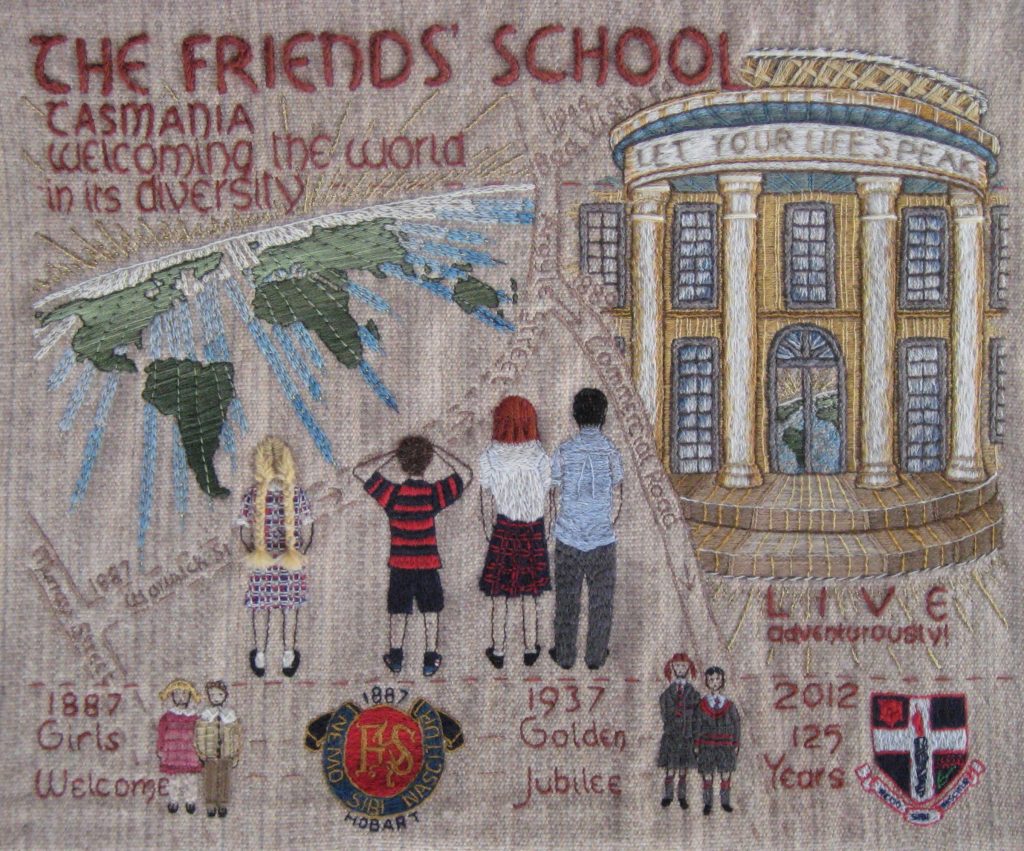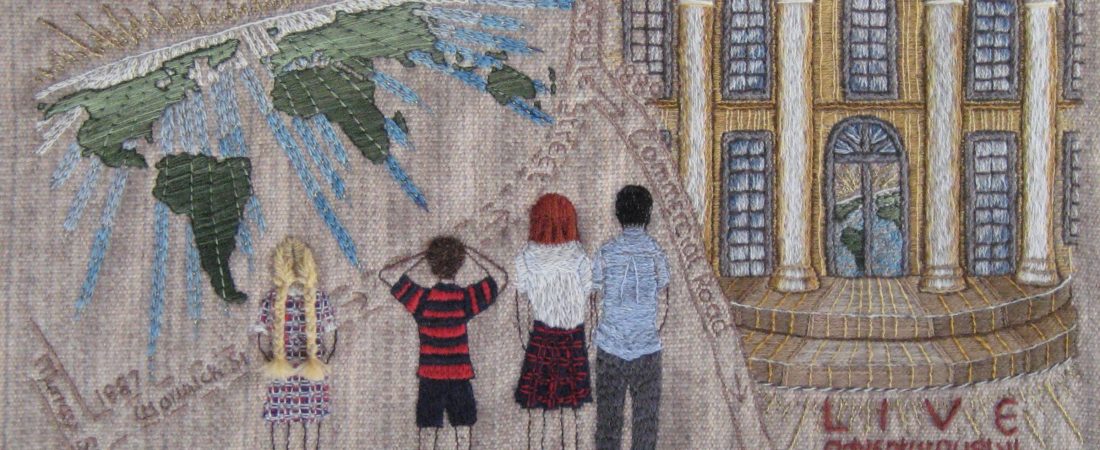The Friends’ School Tapestry Story of Quakerism in Australia
Posted on December 21, 2021

Stitching over time
The Australian Quaker Narrative Embroidery Project began in 2007. A community arts project, it is based on the UK Kendal Quaker Tapestry, which consists of 77 panels illustrating the history of Quakerism from the 17th Century to the present day, and resides in the Meeting House at Kendal in Cumbria, in the Lakes District of England. The Kendal Quaker Tapestry, in turn, is based on the 11th Century Bayeux tapestry.
‘A panel begins with the ideas. Then follows research and the creation of a design using images and text. The completed cartoon is drawn onto calico and tacked onto the woollen fabric ready for the stitching of the embroidery’ (www.quakersaustralia). There are a limited number of stitch types which can be used (including the Quaker Stitch, created specifically for the lettering and writing which appears on panels) and a limited colour palette of Appletons Wool which can be chosen from to paint the pictures in thread. The woollen fabric used for the background was specially created and woven so that all panels have the same unique and neutral background. All designs must follow some basic principles, including the size of the panel and its division in horizontal thirds. Stitch and design guides, which include the history of the project, are available in our library.
As Friends’ is the only Quaker school in the southern hemisphere, its significance to both the history of Quakerism and education was considered important to include in a series of embroidered panels that, together, told the tapestry story of Quakerism in Australia.
The creation of The Friends’ School tapestry began in early 2010 when interested persons in both the School and wider Quaker community convened to discuss the nature and process of the design and stitching of the panel. By early 2013, Cheryl Bain, Music Administrative Assistant, had taken the reins of the (then) flagging project and seconded Nadine Frick, a then new English teacher and Peripatetic Music Tutor, to design the panel, which previous committee discussions determined should include the School’s international connections and feature the School’s portico.
The ball started rolling with design drafts, consultations with then Deputy Principal, Ina Johnson (and later, with Principal Nelson File), meetings about the School’s Quaker history with Kathy Rundle (then Archivist), Julian Robertson (then Quaker Co-ordinator) and Elizabeth Fleetwood, amongst others. This was followed by several workshops over the next 12 months with those interested in stitching the panel and members of The Australian Quaker Narrative Embroidery Project Committee, Friends in Stitches, Tessa Spratt and Cathy Davies.
Monthly stitching sessions, following Sunday Gatherings, continued for a few years. But as with all things, Life happened and numbers dwindled. Even a workshop after the 2016 Yearly Meeting in The Farrall Centre failed to re-ignite the passion of our panel’s stitchers. By the time a travelling exhibition of so-far-completed Australian panels was showcased at The Moonah Arts Centre in 2019, The Friends’ School Panel was still a work-in-progress, receiving its final injection of enthusiasm in 2021, taking it through to completion.

The story of the panel
The Friends’ School, Tasmania
Welcoming the world in its diversity – Let your life speak – Live adventurously
In 1856, in a small cottage in Murray Street, Hobart, adjacent to the then Friends’ Meeting House, Frederick and Rachael Mackie created a school to which, quite radically and notably, girls were welcome. Inclusion was, and is, very much a hallmark of Quaker belief and practise – and gender equity in education has always been a significant aspect of The Friends’ School.
The Murray Street school closed in 1861 – but, on January 31, 1887, the Friends’ School, with Samuel Clemes as principal, opened its doors in Warwick Street.
In 1889, the school moved to its Commercial Road premises in North Hobart and, in 1946, the Friends’ School and Clemes College (est. 1900 by Samuel Clemes – upon his resignation as Principal – and situated at Boa Vista Road and Argyle Street, North Hobart) amalgamated. Today, the school offers education from infant to matriculation-age students over these two campuses.
In 2012, the Friends’ School celebrated its 125th birthday.
This is what the road maps are all about: tracing and locating the school in geographical place along a web of roads that don’t quite connect in this way on any street directory of Hobart but do, none-the-less, connect the school’s history and development in the Hobart landscape.
In much the same way, the school’s emblem, or crest, also marks a journey both symbolically and pictorially, through the use of stylised floral emblems: the Tudor rose, representing the link to our Quaker roots in Britain and the Tasmanian waratah, native to the state of Tasmania.
The portico, or colonnade, is a highly recognisable architectural landmark in Hobart, which was added to the façade of Hobartville – the original building on the Commercial Road campus – in 1923.
The colonnade in the tapestry is as much about the physical building as it is about the values that the Friends’ School is built upon.
‘Let your life speak’ is part of the school’s contemporary logo. The phrase comes from Article No. 27 of the Quaker Advices & Queries, which is as much about outward action as it is about inward contemplation and as much about a bold spirit of adventure and exploration as it is about consideration and reflection.
Nemo sibi nascitur: ‘No-one is born for self alone’ or, ‘We are members one of another,’ is the school’s motto appearing on the crest, and encourages a commitment to service to others, both locally and globally, and a reminder that we are all connected.

The World Map
Tasmania is an island state: getting here and leaving here has always been more of a physical challenge, in terms of travel and logistics. But via sea and air and now, with the wonderful, wonderful Web (new, virtual roads to navigate!), we are connected to the world: we look to it and it looks to us.
The Friends’ School offers its students the opportunity to study for the International Baccalaureate Diploma, assessed by educational professionals from around the world and with a focus on global knowledge and understanding and an emphasis on the education of the whole person. The school has a long association with welcoming international students to its community. It has a strong cultural-exchange programme involving short-term visits of international students to the school and also accepts the enrolment of international students.
‘Not owning the world’ is part of the Quaker belief: it is about a consciousness of our impact upon the environment and of the fact that we are, at best, temporary guardians of the land we traverse. ‘Welcoming the world’ / ‘Welcoming the World in its diversity’ is about inclusion – an embracing of, and respect for, diversity of culture, language and expressions of faith and of diversity in all aspects of our lives and relationships.

In the centre of the tapestry, Friends’ students, dressed in an array of present-day uniforms, are looking to the world ‘out there’ – seeing it in its entirety – and at the glow of the rising sun over its horizon; but, if you look closely, you’ll notice that the world can also be seen through the front door of the building behind the colonnade.
Friends’ equips its students with the knowledge and skills to live well in, and contribute positively to, the world. Friends’ also asks that we look to the ‘world within’, at the same time as it offers us perspectives on both the ‘world without’ and on how we may choose to be in the ‘world without.’
Although we do not own it, we welcome the world in all its diversity – and we go out into the world, letting our life speak.
This panel was designed by Nadine Frick and stitched by members of The Friends community in Hobart. The text for the story of the panel, written by Nadine Frick in consultation with members of the Friends community, accompanies the panel as part of the project.
Stitchers: Cheryl Bain, Ursula Harris, Alison Radford, Nadine Frick, Betty Reeve, Alison Skinner, Ruth Raward, Kate Bain, Kim Roberts, Melinda Rose, Elizabeth Bain, Hannah Powell, Emma Roberts, Stephanie Skinner.
Thanks to: Kathy Rundle, Julian Robertson, Elizabeth Fleetwood, Melinda Clarke and to The Australian Quaker Narrative Embroidery Project Committee, Friends in Stitches, especially Tessa Spratt and Sally O’Wheel, Committee Co-conveners, and Cathy Davies.
The panel can be viewed on the Quakers Australia website
